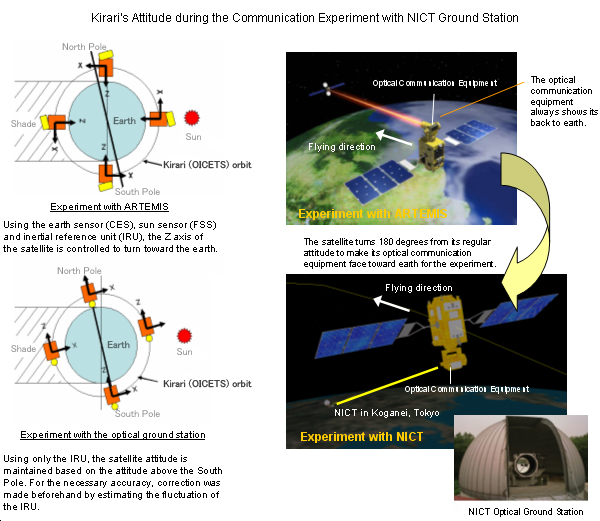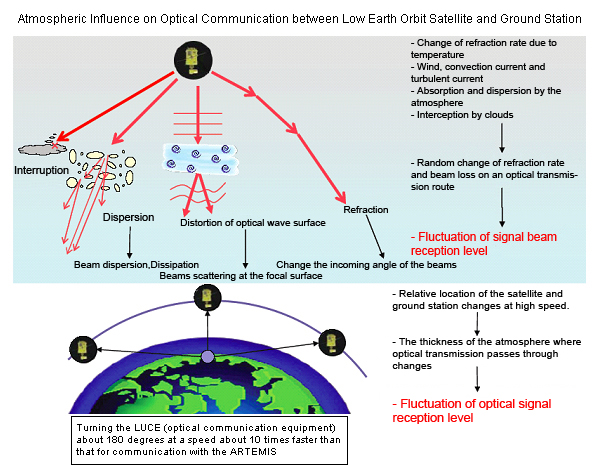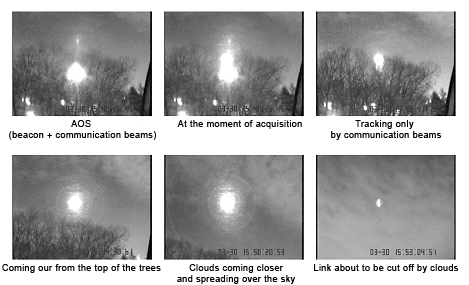Successful Optical Communication Experiment
between the NICT Optical Ground Station and
the Optical Inter-orbit Communications Engineering Test Satellite "Kirari (OICETS)"
National Institute of Information and Communications Technology (NICT)
Japan Aerospace Exploration Agency (JAXA)
The National Institute of Information and Communication Technology (NICT, President Makoto Nagao) and the Japan Aerospace Exploration Agency (JAXA, President Keiji Tachikawa) carried out optical communication experiments between March 22 and 31, 2006 (Japan Standard Time, JST) using laser beams between the Optical Inter-orbit Communications Engineering Test Satellite "Kirari (OICETS)" of JAXA orbiting at an altitude of about 600 km and the optical ground station of NICT in Koganei, Tokyo. The experiments were successfully performed on March 31. This is the first successful optical communication experiment in the world that connected a low earth orbit satellite and a ground station(*).
Optical communications between a low earth orbit satellite like "Kirari" and a ground station require highly sophisticated technology because the satellite has to keep sending laser beams accurately to the ground station while moving at a very high speed although the optical reception level fluctuates remarkably due to atmospheric attenuation and flickers. Therefore, the success of the experiment proves the quality of Japanese technology in the area of optical inter-orbit communication equipment and accurate satellite acquisition and tracking.
The "Kirari" will continue communication experiments with optical ground stations including NICT and German Space Agency (DLR) stations in addition to optical inter-orbit experiments with the Advanced Relay and Technology Mission (ARTEMIS) of the European Space Agency (ESA) to verify the performance of the optical inter-orbit communication equipment in a space environment as well as to evaluate the influence of the atmosphere.
* There are some previous examples of successful optical communication experiments between a geostationary satellite and a ground station including optical communications between the optical terminal developed by NICT aboard JAXA Engineering Test Satellite VI "Kiku #6 (ETS-VI)" and the NICT optical ground station, and between the ARTEMIS and the ESA optical ground station.
[Reference document]
Outline of the Laser Communication Experiment between Satellite and Ground Station
[Video: Satellite acquisition and tracking of the optical ground communication experiment]
http://www3.nict.go.jp/w/w122/ogs/video.html
|
|
Supplementary Information: NICT Optical Ground Station Experiments
NICT has been engaged in research and development of a new generation optical wireless network*1 that enables seamless connection with all optical ground fiber networks*2. Such information communication technology using "optical beams" has been expanded and applied to the space communication networks, thus the era of optical networks connecting everything by optical beams will commence. With this background, NICT treats the spatial optical communication technology between satellites as well as between the ground and satellites as an essential technology, and has been researching and developing optical communications that can reduce the impact of atmospheric flickers through the development of next generation inter-orbit optical communication equipment and the use of the optical ground station in Koganei, Tokyo.This technology is also expected to be one of the fundamentals that supports a safe and secure society since it enables large volume transmission of environmental and disaster observation data acquired by earth observation satellites.
Through these experiments, we were able to measure the impact of atmospheric flickers on optical communications between the ground station and the low earth orbit satellite that flies at an orbital speed of about 7 km per second. It is not only academically significant, but also expected to be widely applied to various areas including optical communications between buildings scattered around urban areas, spatial communications with flying objects such as aircrafts, and optical wireless technologies on the ground.

NICT Optical Ground Station at the Koganei Headquarters
NICT engages in various optical experiments mainly using an optical telescope with a diameter of 1.5 m.
- [Terminology]
- *1 New generation optical wireless network: This is a robust global network that is wireless, seamless, ubiquitous, and uses broadband, including both the ground and space systems, by considering optical and high frequencies as new network recourses. NICT is aiming at establishing safe wireless communication technologies to provide advanced wireless services for use under various situations and conditions. The optical wireless system technology that turns spatially transmitted optical beams back into fiber optic signals without the optical/electric conversion of fiber signals is important as a network technology that seamlessly connects different networks by only using optical signals.
*2 Optical ground fiber network: This is a fiber network that undertakes end-to-end information transmissions of the optical network including efficient nodes of a high quality to realize a super-high speed network. When we control optical signals for optical communications, we usually use a switch to turn these signals on and off by using electric signals. In order to enable a super-high speed communication network, all switching operations must be optically carried out. It is expected that in the future all ground fiber networks will become all-optical networks.



Kirari-NICT Ground Station Experiment Results
| Task No. | Date, Month, Time (Japan Standard Time) | Conditions | Results |
|---|---|---|---|
| 1 | March 22 00:37:28-00:38:40 |
The "Kirari" received beacon beams from the optical ground station and the station received optical communication beams from the "Kirari" for about 16 seconds. The bit error rate was not measured. | Acquisition and tracking were successfully performed. |
| 2 | March 24 01:02:27-01:03:53 |
The experiment was cancelled due to cloudy weather. | Cancelled |
| 3 | March 29 00:23:56-00:29:48 |
The "Kirari" received beacon beams from the optical ground station and the station received optical communication beams from the "Kirari" for about 6 seconds. The bit error rate was about 10-5. | Communication from the satellite to the ground station was successfully performed. |
| 4 | March 31 00:48:26-00:53:10 |
Beacon beams were turned off, and continuous acquisition and tracking were verified for 4 minutes and 44 seconds through the optical communication beams. | Bi-directional communications were successfully performed. |
- Continuous acquisition and tracking were carried out for 4 minutes and 44 seconds between 00:48:26 and 00:58:10 on March 31, 2006 (Japan Standard Time), and communications were successfully performed between the "Kirari" and the NICT optical ground station.
- Laser beams are invisible as their wave length is in the 800 nanometer range (infrared rays.) Dispersed beams due to the atmosphere are not harmful to human, and we concentrated on carrying out the experiment safely without mistakenly directing the beams in other directions so as not to interfere with other activities such as aircraft monitoring.

* The above photos were taken by the infrared camera.
For inquiries:
NICT Public Relations Office
Tel: +81-42-327-6923, Fax: + 81-42-327-7587
![]()
JAXA Public Affairs Department
Tel: +81-3-6266-6413 to 6, Fax: +81-3-6266-6910
<
NICT Space Communication Group
Tel: +81-42-327-5825, Fax: +81-42-327-6699